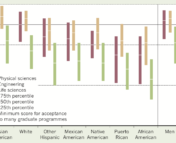- Article: Physics GRE Scores of Prize Postdoctoral Fellows in Astronomy
- Authors: Emily M. Levesque, Rachel Bezanson, Grant R. Tremblay
- First author’s institution: University of Washington
- Status: Published on arXiv
Note: This article was published in December of 2015, and has been extensively discussed online. While not new, it serves as a background for current events and to link relevant old-school Astrobites posts that could otherwise go unnoticed for newer readers.
Updates: We included the confirmation from UT Austin, David Charbonneau’s announcement on Twitter, and the confirmation from University of Washington.

Number of eliminated applicants if institutions used strict Physics GRE score cutoffs (x-axis) in their admissions. Left: Absolute numbers. Right: Fractions.
As another graduate admissions season approaches, it is time the students start taking the GRE (Graduate Record Exam) and send their scores to the universities they aim to obtain their next degrees at. Most astronomy graduate schools additionally require the Physics GRE (PGRE), but their role is being questioned. Recently, the University of Arizona, the University of Texas at Austin and the University of Washington eliminated the PGRE requirement from their graduate admissions. In light of these events, we bring back today’s article, published almost a year ago, which reports a case study on prize-winning postdoctoral fellows in astronomy and show the impact of strict PGRE score cutoff rules for graduate school applications in the United States.
Proud to work at the U of Arizona @UofA, where @azstewobs has now eliminated the Physics GRE requirement from astro grad applications.
— Beth Willman (@BethWillman) August 27, 2016
Breaking: University of Texas Austin @UTAustin Astronomy @UTAstronomy votes to eliminate physics GRE from graduate admissions.
— David Charbonneau (@ExoCharbonneau) August 26, 2016
As all applicants probably know by now, these exams are not cheap: The general and the subject GRE cost, as of writing this bite, $205 and $150, respectively. Each test taken offers 4 free reports to institutions chosen by the test taker, but each report after those costs $27. Non-English native speakers face an even heavier burden, having to pay an extra $100-200 for English certification tests. What this means is that only those who can afford these fees will be able to apply for graduate admissions.
Moreover, independent researchers have also demonstrated that ethnicity and gender correlate with the GRE and PGRE scores: For instance, students of color and women may have their scores adversely affected by stereotype threat. When graduate school admissions place strong weights on standardized test scores or enforce strict cutoff rules, this poses a steeper barrier for applicants who are in these demographics.
PGRE scores and academic success in astronomy
Today’s article reports and discusses the results from a questionnaire sent to prize-winning (Sagan, Einstein, Hubble, NSF and/or Jansky) postdoctoral fellows in the United States. Their achievements are assumed to be a better measure of academic success, but the authors make it very clear that it is a narrow, incomplete and non-inclusive definition of “success”. In this questionnaire, the respondents were asked about their PGRE scores and to answer a batch of questions (see page 5 of the article). The respondents identified themselves as 50% male, 35.5% female and 14% other/non-specified. The histogram of their scores are shown in Fig. 1.

Figure 1. Left panel: “expected” histogram of PGRE scores assuming they correlate strongly with academic success and do not correlate with gender (considering the gender ratios of respondents). Right panel: actual results from the poll. The histograms are stacked one on top of the other.
In Fig. 1, the distribution of PGRE scores spans the full range of percentiles, with the ~42% of the female respondents below the 50th percentile, in contrast with ~29% percent of male ones. This kind of correlation is also known among scientists as nuisance systematics: They illustrate the harm of using strict cutoff rules for graduate admissions, which would have a stronger impact for female students, in this particular case.
The authors also verify that the PGRE scores do not significantly correlate with the number of first author publications, which is an indicative of scientific productivity (see Fig. 2; if they were correlated, there would be a very clear trend of higher number of published papers with a growing PGRE percentile). This result show that the number of publications is insensitive to the PGRE scores, which means that one should not be used to counteract the other, at the expense of weighting in more “noise” than actual “signal”. People from admission committees claim, on the other hand, that they have anecdotal evidence for correlation between the verbal reasoning part of the general GRE score and academic success.

Figure 2. From left to right: The number of first author papers published by the respondents before, during and after exiting graduate school. There is marginal evidence (p-value*) for the weak correlations (Peason r**) between these numbers with the respondents PGRE scores. The “error bars” represent ranges of percentiles for the respondents who did not remember exact numbers.
Reviewing the role of standardized exams
All that said, it seems that we are slowly changing towards a different perspective on astronomy graduate admissions in the United States. The American Astronomical Society released, last year, an official statement where they question the (P)GRE requirements, pointing out that these standardized exams dramatically lower the number of women and students of color entering astronomy graduate programs. They recommend American institutions to review the role of the exams in their admissions towards eliminating or making it optional to present (P)GRE scores as a metric of evaluation of the applicants.
The Inclusive Astronomy Conference, which took place at the Vanderbilt University in June of 2015, has been of particular importance this discussion. Their vision statement, which includes the elimination of barriers to educational access for underrepresented minorities, was recently endorsed by the AAS, and this serves as a tangible milestone towards a more inclusive astronomy.
* p-values measure the probability of obtaining an equal to or more extreme result (in our case, a higher number of first author papers accompanying higher PGRE scores) than what was actually observed assuming that there is absolutely no correlation between the two statistics being analyzed.
** Pearson r measure the linear correlation between two variables.




Is PGRE required for astrophysics course?
What exactly should I do if I want a master degree course in Astrophysics?